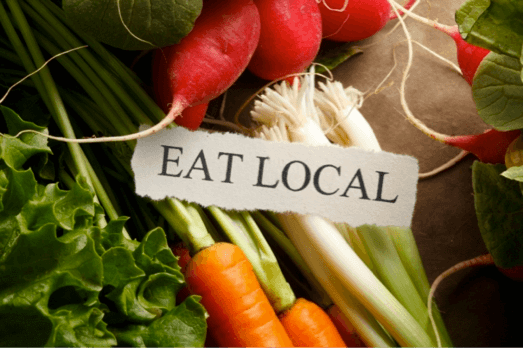Eating Healthy on a Budget: Part II
By Blair Lindler
Eating Healthy on a Budget: Part II
Last week, in Part I we talked about 6 simple, yet practical tips for being conscious of your budget.
Today, we’re going to move on to specific tips about FOOD (my most favorite thing in the world)…
And how you truly can master eating healthy on a budget.
15 Tips for Eating Healthy on a Budget:
- Find the discount grocery store in your area – I swear by Aldi stores – their produce and their meats are INCREDIBLY priced! We don’t have one in my town, but there’s one in the town my fiancé lives in, so I always make a trip there when I’m visiting to stock up (my grocery bill often drops as much as $20!)
- Get a Sunday Paper – Not to read the news, but to get a hand on those sale papers! And DON’T throw them away until the next Sunday comes along – no matter how much preparation you have for grocery shopping, you’ll inevitably forget something. And having those sale papers handy will help you know either where to shop or will help you get that price at another store (see tip #4)!

- Shop sales – I am not a hoarder, but I 100% believe in stocking up on a good sale. If meat is on a great sale, I will often buy 2-4x more than what I would normally purchase. Sure, it’s a bit more expensive on the front end, but on the back end, that’s 2-4 weeks that I won’t have to purchase that item. Just stick the meat in the freezer and it will be there waiting for you.
- Use Price Match – Many stores will match the prices of their competitors to keep your business. Find out which stores do this (Walmart does!), and then keep your weekly sale ads handy as you shop. Don’t worry about “inconveniencing” someone at the register – YOUR BUDGET IS MORE IMPORTANT!

- Check unit prices – Just because you’re purchasing frozen chicken breasts does NOT mean that’s the best deal. I’ve found that sometimes the fresh (and not pre-packaged) meat at the meat counter is cheaper than the frozen. COMPARE COMPARE COMPARE!
- Use wild game – This will either require you to become a hunter/fisher-woman, or to befriend someone who is. There are SO many ways that you can “strike deals” with hunters to get fresh, wild, lean game. My fiancé’s brother hunts while my fiancé does not. So we struck a deal with his brother – when he shoots a deer, we’ll pay the processing, and then the meat is split evenly between us. The quality of this meat is incomparable and the price for processing can be as low as $1-$2 per pound. PLUS you’ll end up with a lot of meat at one time, which goes back to that concept of “stock up.”
- Shop seasonal – Buying oranges in the winter time will result in you paying more for that orange than if you purchased it during their main season. So find what’s seasonal and try to stick to those items. I personally have a soft spot for tomatoes, so I purchase them year round – and that’s okay because I shop seasonally for a lot of my other vegetables. (Visit THIS SITE to find out what’s in season in your state!)
- Plant a garden – You don’t have to have a yard – you can have a container garden. Whether those plants are in the ground or in a pot, this is the BEST way to save money! Your garden will change as the seasons change, and will leave you with fresh vegetables for as long as you keep it going. It’s a lot of work (I can’t lie here), but giving a little time to tend to the earth will leave you with a harvest to enjoy. Plus this is a great way to teach kids hard work, dedication, and sustainability.
- Buy Local – I don’t usually go to farmers markets because I feel like as a general rule, their prices are higher. If you have the ability to, that’s fine! But one tip my grandfather taught me early in life is to find a “garden”. When I was young and visiting my grandparents, he’d put me in the front seat of his Buick (they’ve only owned Buick’s) and drive me out to “the garden,” a patch of vegetables that was too small to be a farm but too big to be a personal garden, where the owner sold the extras of his crops for rock bottom prices. These “gardens” can be found nearly anywhere. Look for those hand painted signs on plywood and you’re golden. Avoid the commercial look or anything that has a credit card machine. You’re looking for the Mom and Pop garden where they leave your vegetables on a picnic table in a grocery bag next to a jar for you to deposit your money. You can also get farm fresh eggs this way!

- Have soups be your friend – Soups come in endless varieties and flavors. They’re a great budget friendly option because their volume often comes from water. Your meats and vegetables often go further in chili’s and soups. Daniel, my fiancé, will often make one large pot of soup on Sunday and will have that soup for every dinner of the week (he’s one of those people who don’t need variety in the food they eat), costing him about $10 for the whole pot.
- Ask the Meat Manager – Sometimes there are markdowns on meats, so just ask the meat manager if/when they do markdowns. That will help you decide when to shop for meats at that particular store and if you see marked down meat, BUY IT! There’s nothing wrong with it! Buy it, freeze it, marinade/season it, cook it, and enjoy it!

- Look into “members only” stores – I have never shopped at or even been into stores like Sam’s or Costco, however, I have several friends who swear by them. Look into these options and see if they’re right for you, and if the member prices are justified in your budget. But don’t assume that just because they’re a bulk/warehouse store that they have the best prices. Keep those sale papers handy when you shop there and compare the unit prices to what you know are in the “regular” grocery stores.
- Use coupons – There are several websites that provide coupons. You can get coupons from the Sunday paper and grocery stores can offer e-coupons that are exclusive to their store (Harris Teeter has e-VIC). USE THEM! Choose selectively what products you purchase using a coupon – my general rule is that if I wouldn’t normally purchase it or if it’s not fat loss friendly, then that coupon ends up in the trash (Check out: SouthernSavers, CouponMom, or SlickDeals)

- Check your local discount stores – I’m talking Dollar Tree, Family Dollar, Dollar General, Roses, Big Lots…these stores are GREAT for finding steals!! The Dollar Tree gets shipments of “day old bread” of name brands (I’m talking Pepperidge Farms) every week among other finds (now obviously that’s not fat loss friendly, but if you’re trying to feed a family that WANTS bread from time to time, this is a great place to find some). I’ve found canned tomatoes, no salt canned vegetables, individual (name brand) packets of drink mix, etc for up to 74 cents less than what you would pay at the grocery store.
- Always COMPARE COMPARE COMPARE – No matter where you’re shopping, it’s a business. Just because they have a good price on a couple of items doesn’t mean that they have good prices on everything else. You obviously have to pick/choose your battles with this (you can’t go to 8 stores!), but please do keep this in mind. Every store is out to make money, so you have to shop carefully and mindfully.
BONUS: For your supplements, I HIGHLY recommend that you compare shop online. For example, compare vitacost prices against GNC prices. Sometimes you’ll stumble upon a sale that will save you the few bucks that will make it worth using a different vendor.
I hope these tips are useful for you – they’re the ones that I use to help keep my budget in check.
Check out the BeyondFit Life Club! Workouts, recipes, community and more!

